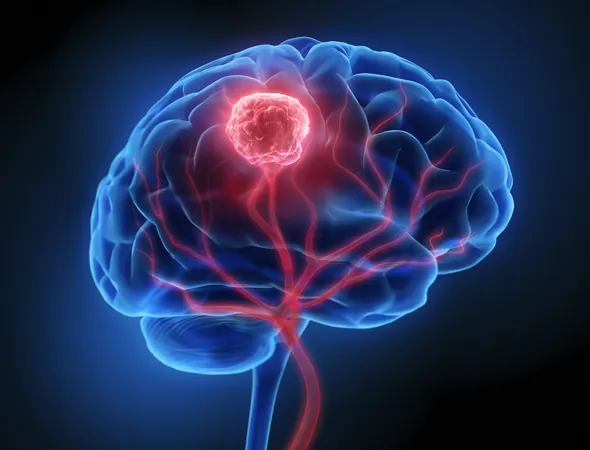
Groundbreaking Stem Cell Discovery Sparks Hope for Advanced Glioblastoma Treatments!
2025-01-15
Author: Yu
Significant Breakthrough in Glioblastoma Research
In a remarkable new study, researchers have uncovered a novel type of stem cell in the human brain that could revolutionize treatment options for glioblastoma (GBM)—one of the most lethal brain tumors affecting adults. This breakthrough offers new insights into how brain cells may incorporate developmental mechanisms to form these aggressive tumors. Additionally, the team has crafted a disease-risk map outlining increased susceptibility to autism spectrum disorder linked to specific neuronal populations during development.
Expert Insights on Brain Cancer and Developmental Pathways
According to Arnold R. Kriegstein, a senior author and professor of neurology at the University of California, San Francisco (UCSF), “Brain cancers are believed to exploit developmental pathways and stem from ‘cancer stem cells’ that mimic embryonic cell types. Our approach may aid in identifying these origins.”
Challenges in Early Detection of GBM
The published findings in Nature are led by Li Wang, a postdoctoral researcher from Kriegstein's laboratory at UCSF. One critical challenge with GBM is its ability to invade normal brain tissue, making early detection difficult. “By the time symptoms appear, the tumor has often advanced beyond surgical intervention, and recurrence is almost guaranteed despite existing treatments,” Kriegstein explained.
Conducting Extensive Genomic Analysis
To conduct their extensive study, the researchers performed a genomic analysis of brain cells retrieved from deceased individuals aged from infancy to their early twenties. Samples were acquired from the National Institutes of Health’s NeuroBioBank and various UCSF-affiliated hospitals. The research involved assessing gene expression across thousands of individual cells to visualize patterns of healthy brain development.
Advanced Techniques in Brain Research
Utilizing advanced techniques like paired single-nucleus chromatin accessibility and transcriptome data from 38 brain tissue samples, the researchers focused on the prefrontal and primary visual cortices across five developmental stages—ranging from the first trimester to adolescence. They also employed spatial transcriptomics to reveal the intricate spatial organization and communication pathways between cells.
Discovering Tripotential Intermediate Progenitor Cells (Tri-IPCs)
Significantly, the team disentangled lineage relationships among different progenitor subtypes during the transition from neurogenesis to gliogenesis, pinpointing a unique kind of progenitor known as tripotential intermediate progenitor cells (Tri-IPCs). These Tri-IPCs hold the capacity to generate GABAergic neurons, oligodendrocyte precursor cells, and astrocytes, potentially setting the stage for future tumorigenic events.
Understanding Brain Diseases
“Until now, our understanding of how brain diseases originate at different developmental stages has been limited,” Kriegstein noted. “Our research provides a genetic roadmap revealing which processes go awry, contributing to various brain disorders.”
Focus on Neuronal Regions and Cognitive Functions
The study also focused on the genetic expressivity of different neuronal regions, particularly the frontal and occipital lobes, which are pivotal for cognitive functions such as learning and language. Among their findings, the researchers discovered distinct stem cells in the developing brain capable of producing the diverse cell types that makeup glioblastoma tumors, indicating a potential link between normal brain development and tumor formation later in life.
Creating a Risk Map for Autism Spectrum Disorder
Integrating their data with large-scale genome-wide association studies led to the creation of a risk map identifying connections between specific neuron types and autism spectrum disorder, particularly among intratelencephalic neurons during the crucial second trimester.
Implications for Future Therapeutic Strategies
This groundbreaking research not only sheds light on the origins of glioblastoma but also reinforces the importance of understanding brain development processes to advance future therapeutic strategies for brain cancers and related neurological disorders. The implications of these findings could pave the way for targeted treatments that effectively disrupt the mechanisms leading to tumor formation in vulnerable populations. Exciting times lie ahead in the fight against GBM!

 Brasil (PT)
Brasil (PT)
 Canada (EN)
Canada (EN)
 Chile (ES)
Chile (ES)
 Česko (CS)
Česko (CS)
 대한민국 (KO)
대한민국 (KO)
 España (ES)
España (ES)
 France (FR)
France (FR)
 Hong Kong (EN)
Hong Kong (EN)
 Italia (IT)
Italia (IT)
 日本 (JA)
日本 (JA)
 Magyarország (HU)
Magyarország (HU)
 Norge (NO)
Norge (NO)
 Polska (PL)
Polska (PL)
 Schweiz (DE)
Schweiz (DE)
 Singapore (EN)
Singapore (EN)
 Sverige (SV)
Sverige (SV)
 Suomi (FI)
Suomi (FI)
 Türkiye (TR)
Türkiye (TR)
 الإمارات العربية المتحدة (AR)
الإمارات العربية المتحدة (AR)